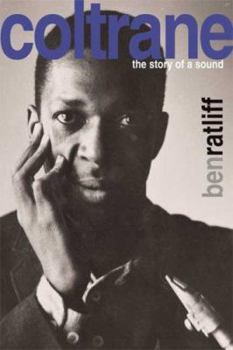Coltrane: The Story of a Sound
Select Format
Select Condition 
Book Overview
John Coltrane left an indelible mark on the world, but what was the essence of his achievement that makes him so prized forty years after his death? What were the factors that helped Coltrane become... This description may be from another edition of this product.
Format:Hardcover
Language:English
ISBN:0374126062
ISBN13:9780374126063
Release Date:September 2007
Publisher:Farrar Straus Giroux
Length:250 Pages
Weight:1.15 lbs.
Dimensions:0.9" x 6.4" x 9.3"
Customer Reviews
5 ratings
Coltrane: The Story of a Sound
Published by Thriftbooks.com User , 14 years ago
The focus of this book is the evolution of John Coltrane's sound and (in part two of the book) the adulation and reverence that many jazz musicians have had for his music after his death. This book is not a rehash of previously published books on Coltrane: the author thinks for himself, writes very well, and has intelligent things to say about Coltrane and his influence on jazz. Allow me a proviso. I haven't yet read or looked into Lewis Porter's John Coltrane: His Life and Music, which I understand is the current standard biography on Coltrane (I try to buy most of my books used and haven't come across it yet, and I prefer to read chronologically, if possible), so if the book under review is derivative in any significant way from Porter's, I don't know it. Of the four books I've recently read on Coltrane (see my reviews) I recommend Eric Nisenson's Ascension: John Coltrane And His Quest as a complement.
Good Read
Published by Thriftbooks.com User , 15 years ago
A good read for anyone (musician, jazzophile, or neither) interested in Trane or curious as to why people are so devoted to his music. Well written and fresh perspective on Trane's musical evolution and its impact. Not a re-hash of his biography.
Beginner's view of Coltrane
Published by Thriftbooks.com User , 16 years ago
As a beginning student of jazz piano it was enlightening to understand how the various modalities, rhythms, and chordal structures are used by one of the greats. Wonderful to have this perspective.
Coltrane
Published by Thriftbooks.com User , 16 years ago
Ratliff does an extrodinary job on what had to be a difficult subject. He has a way with words like very few authors I've read in a long,long time. Not only is his vocabulary boundless but the way he uses his word knowledge is beyond about anything one finds today. He must be the finest Jazz writer in the USA.
Trane Dissected
Published by Thriftbooks.com User , 16 years ago
Here the music of John Coltrane, arguably one of America's most important 20th Century Artists, has been laid bare on the musical autopsy table by a seasoned and confident art and Jazz critique, Ben Ratliff. To those of us from the 1960s, whose intellect and artistic sensibilities were being constantly challenged -- even assaulted -- by a need to understand Coltrane's music, this is a welcomed contribution to the history of Jazz and to a better understanding of the music theory behind post-modern Jazz music and its familiar compositions. Using a dialect that fuses the vernacular of bebop with his own rich self-invented language of the art critic, Ratliff wields a deft scalpel in this his own self-styled musical autopsy room. In part one of this two-part dissection laboratory, Raliff examines Coltrane's music using dense, sometimes even layered and often deeply intellectual language and analysis borrowed from music theory, excerpted from the tapes of live Jazz presentations, and from the "head sessions' of many famous Jazz musician's practice sessions. He does so with great erudition but without over-hyping or being pretentious, boring or pedantic. Ratliff situates Coltrane's development as a musician and as a person in the context of a politically and socially hectic, but artistically rich and fertile, time. For instance: He points out that Bebop was a new language of blues-based modernism, developed in NY in the early 40s by Charley Parker and Dizzy Gillespie and associated with fast tempos, asymmetrical melodic lines, and chord harmonies inspired by Stravinsky, Debussy, and Bartok. Ratliff explains Parker's eureka moment as being when he used the higher interval of a chord as a melody line and backed them up with appropriately related changes - only then could he play everything he had been hearing. He explains too how the two giants of the post-Charley Parker era, John Coltrane and Sonny Rollins, "separately colonized the post-Parker universe." With great precision and an innate sensitivity to what is important, he explains Coltrane's idea of sheets of sound as being similar to the sketching of a "thin-pointed pen" versus that of a "paint-roller" -- both tracing out the same melodies. Or, as Coltrane challenged Wayne Shorter to do: "play all the sounds you can hear emanating from the "dronggg" caused by dropping a forearm across the piano keys. Part I covers Coltrane's graduate degrees in advance music theory from both Miles Davis and his apprenticeship under Theolonius Monk; his brief stint with the master of the Avant-Garde, Ornette Coleman; and the expansive musical developments and interpretations he acquired from associations with Sun Ra, Rav Shankar, and many others. Coltrane's language on the saxophone was the language of sophistication. He played lavishly around, behind, above and outside simple changes; and he did so with great depth, stamina, fervor, and tenderness. In what is not an altogether apocryphal story, Raliff rela




